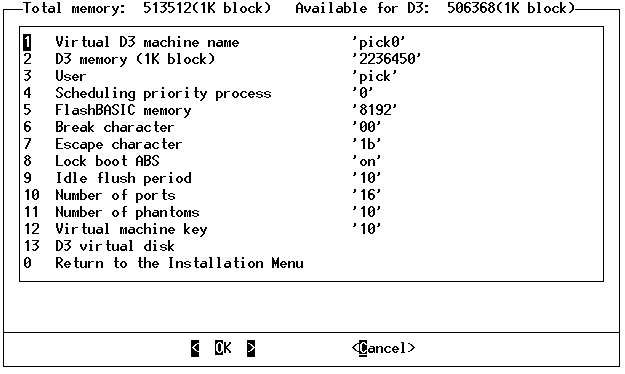Display/Modify D3 Configuration menu
This menu displays the default configuration during the installation and upgrade processes. It displays when the Display/Modify D3 Configuration option is selected from the D3 Installation menu.
As an option is highlighted, a brief description displays in the lower left portion of the screen. Default values are located in the Installation worksheet. The numbers in the following figure are an example.

| Menu Option | Description |
|---|---|
| Virtual D3 machine name | The name of the D3 virtual machine. If the virtual machine exists, its configuration file is read and displayed. |
| D3 memory (1 K block) | D3 memory is also referred to as core memory. The amount of shared memory the D3 process
allocates for itself while the virtual machine is running. The total amount of physical system memory and shared memory available for D3 is shown at the top of the screen. The maximum amount is 200 GB. |
| User |
The name of a valid UNIX user. The user statement contains pick by default. If a non-root user is to be used, the user must be created before the D3 virtual machine is booted. To make the user statement empty, select this option, press the Spacebar, and then press Enter. See Creating a UNIX user account for D3 for more information. |
| Scheduling priority process | This parameter is a signed value that adjusts the priority of the D3 process relative to
other regular UNIX processes. A negative value gives a higher priority. A positive value gives a lower priority. Acceptable values are -19 (highest priority) to +20 (lowest priority). |
| FlashBASIC memory | Modifies the amount of memory (1 KB block) set aside to contain the shared FlashBASIC code
most commonly used by the application. The minimum recommended size for this parameter is 1024 (1 MB). The maximum size for this parameter is 32 MB. Some FlashBASIC applications might require 10 to 15 MB (10240 KB to 15360 KB for example). Usage is monitored using the TCL shpstat command. If this field is empty, the code produced by the FlashBASIC compiler will not be shared. Note: When Flashed object code is not shared in memory, every instance of that
code is copied. This reduces the amount of main memory available to users and can result in
excessive use of swap space, that impacts system performance.
|
| Break character | The hexadecimal value of the character used to indicate the D3 break sequence. |
| Escape character | The hexadecimal value of the character used to generate an escape sequence. |
| Lock boot ABS | Locks the ABS into memory. This option should always be ON. Turning this option OFF saves approximately 2 MB in memory, but causes significant performance loss. |
| Idle flush period | Specifies the rate, in seconds, at which the memory is flushed back to disk. The smaller the number, the more frequently the flush takes place and a higher number of disk writes occur. A value range of 10 to 20 seconds is adequate for most systems. |
| Number of ports | This parameter should be equal to the number of users for which the software is licensed,
plus the expected number of parallel and/or serial printers. Allocating more ports than necessary simplifies upgrade procedures and future expansions when the number of licensed users must be increased. However, declaring more ports than are required increases the amount of time required to boot and shutdown the D3 virtual machine. Note: Changing the
number of ports after D3 installation is complete, requires a full file-save and restore of
the system.
|
| Number of phantoms | The number of phantom ports expected to be used. A simple calculation to estimate the number of phantoms is one-eighth of the number of licensed users, with a recommended minimum of 16 phantoms. |
| Virtual Machine key | The hexadecimal number that is a unique identifier for this particular D3 virtual machine.
Each virtual machine must have a unique identifier. If several D3 virtual machines are running on the system, this identifier must be different for each one. |
| D3 virtual disk |
This option allows definition of the disk space D3 data uses. If this is a new installation, a free partition must be selected on the installed disks. It is possible that no default virtual disks will be shown. Select disk volumes using the [a]dd or [u]se exist options. The D3 virtual disk menu and its options are discussed in the next section. |
| Return to the Installation menu | Returns to the D3 Installation menu. |